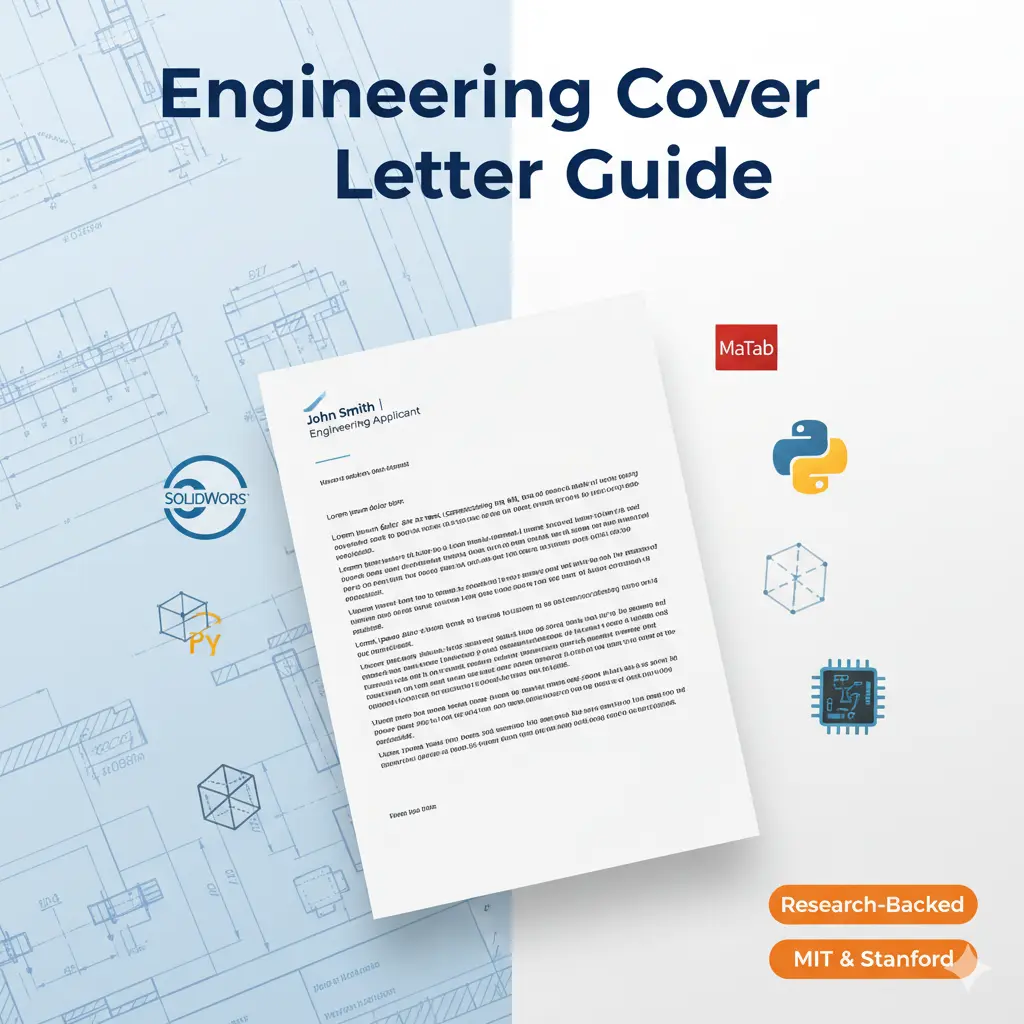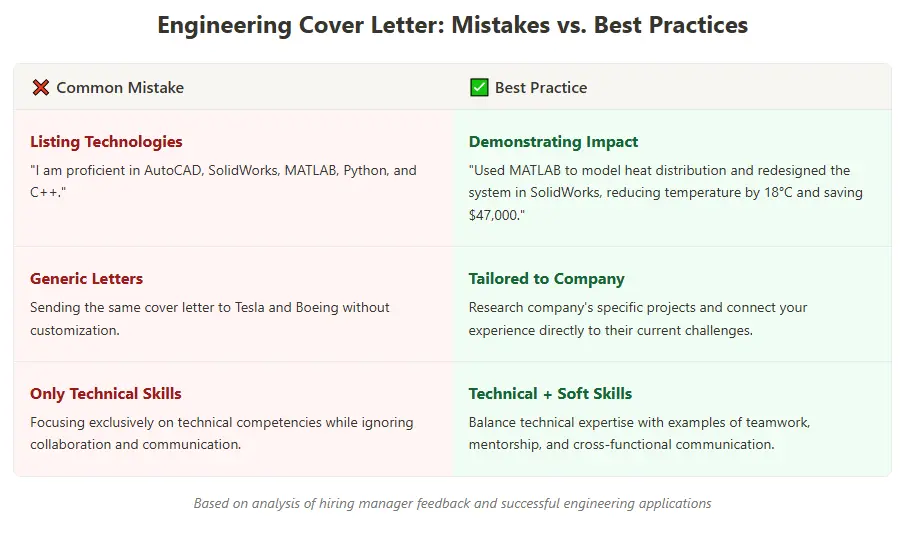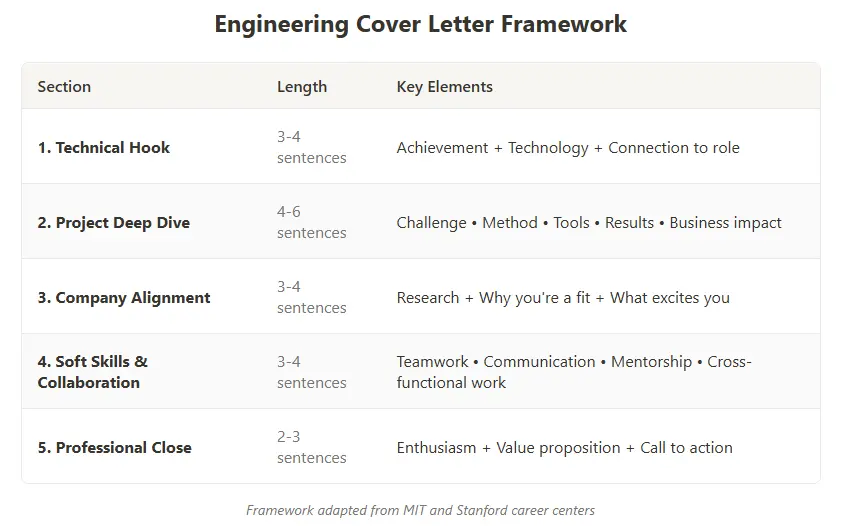Engineering Cover Letter: The Complete Guide + Real Examples
Learn the research-backed framework that gets engineering interviews. Includes examples, common mistakes, and data from 625+ hiring managers.

Research-Based Approach
This guide synthesizes insights from multiple authoritative sources to provide evidence-based advice on engineering cover letters:
Academic Institutions:- MIT Career Advising & Professional Development
- Stanford Career Education
- Engineering Communication Labs from top universities
- Resume Genius survey of 625 U.S. hiring managers (2024)
- LinkedIn Talent Solutions survey of 1,453 recruiting professionals (2024)
- Insight Global AI in Hiring survey of 1,005 hiring managers (2024)
- IEEE-USA Salary & Benefits Survey of 6,340 engineers (2024)
- U.S. Bureau of Labor Statistics employment data
TL;DR: What the Data Shows
According to hiring manager surveys and top engineering schools:
- 94% of hiring managers say cover letters influence interview decisions (Resume Genius, 2024)
- 49% will interview a weak candidate with a strong cover letter; 18% will reject a strong candidate with a weak one
- 87% of hiring managers actually read cover letters (Resume Genius, 2024)
- Stanford research shows recruiters spend just 6 seconds initially scanning applications
- MIT career advisors emphasize that cover letters demonstrate communication skills—critical for engineering roles
- LinkedIn's 2024 data reveals that 6 of the top 10 most sought-after skills are soft skills (communication, leadership, analytical thinking)
Why Most Engineering Cover Letters Fail
According to MIT's Career Advising & Professional Development, one of the most common mistakes engineers make is failing to use their cover letter to demonstrate communication skills. With recruiters spending an average of just 6 seconds on initial application review (Stanford Career Education), your cover letter must immediately show value.

The Three Critical Mistakes
Mistake #1: Listing Technologies Instead of Demonstrating ImpactAccording to the 2024 Resume Genius survey, 47% of hiring managers say showcasing achievements is a primary purpose of cover letters—yet most engineers simply list skills.
Weak approach:"I am proficient in AutoCAD, SolidWorks, MATLAB, Python, and C++. I have experience in mechanical design and thermal analysis."Strong approach:
"When our team faced a thermal management challenge in a compact electronics enclosure, I used MATLAB to model heat distribution patterns and redesigned the cooling system in SolidWorks. This reduced operating temperature by 18°C and eliminated the need for active cooling, saving $47,000 in production costs."Why it works: You're demonstrating how you applied tools to solve a specific problem with measurable business impact.
Mistake #2: Writing Generic Cover Letters
Research from multiple university career centers shows that tailored applications significantly outperform generic ones. According to MIT's guidelines, successful cover letters should be "directed towards a specific position or company."
Engineers who apply to both semiconductor companies and automotive manufacturers with identical cover letters miss the opportunity to demonstrate genuine interest and relevant expertise.
Mistake #3: Ignoring Soft Skills LinkedIn's 2024 Future of Recruiting survey found that 6 of the 10 most sought-after skills are soft skills. For engineers, this means demonstrating:- Cross-functional collaboration
- Communication with non-technical stakeholders
- Project management and timeline adherence
- Mentorship and knowledge-sharing
According to IEEE-USA's 2024 salary survey of 6,340 engineers, the primary reasons engineers switch employers are advancement opportunities and new responsibilities—both of which require strong soft skills.
The Engineering Cover Letter Framework
This structure adapts frameworks from MIT and Stanford career centers, validated against patterns in successful engineering applications.

Paragraph 1: The Technical Hook (3-4 sentences)
Purpose: Immediately demonstrate relevant expertise and connection to the role. Formula: [Specific technical achievement] + [Relevant technology/method] + [Connection to company's needs] Example (Mechanical Engineer):"When I read about [Company]'s work on next-generation electric vehicle thermal systems, it immediately connected with my recent project at [Previous Company], where I led the redesign of our battery cooling system that improved thermal efficiency by 23% while reducing weight by 3.2kg. With five years specializing in automotive thermal management and hands-on experience with CFD simulation tools, I'm excited to contribute to your advanced powertrain engineering team."
Paragraph 2: The Project Deep Dive (4-6 sentences)
Purpose: Prove technical competency with specific details and measurable outcomes. Must include:- The technical challenge
- Your methodology and approach
- Tools/technologies used
- Quantifiable results
- Business impact
"At [Company], I tackled persistent signal integrity issues affecting our high-speed PCB designs. After conducting extensive analysis using Keysight ADS and Ansys HFSS, I identified unexpected impedance mismatches in our via structures. I redesigned the stackup architecture, optimized via placement using electromagnetic simulation, and implemented new design rules. The result: signal integrity violations dropped by 87%, first-pass PCB yield increased from 64% to 94%, and we reduced prototype iteration cycles by three weeks—saving approximately $180,000 annually."
Paragraph 3: Company Alignment (3-4 sentences)
Purpose: Show research and explain mutual fit.Stanford Career Education emphasizes that effective cover letters "work in your knowledge of the company and industry and its products, services, customers, and recent news."
Example (Software Engineer):"I've been following [Company]'s transition to microservices architecture and your recent tech blog posts about distributed system challenges at scale. This resonates with my experience leading the migration of our monolithic application to Kubernetes-orchestrated microservices, where we improved system reliability from 99.2% to 99.9% uptime. The opportunity to tackle distributed systems problems at [Company]'s scale is exactly the challenge I'm seeking."
Paragraph 4: Soft Skills & Collaboration (3-4 sentences)
Purpose: Demonstrate you can work effectively in teams and communicate across functions. Example:"Beyond individual technical contributions, I've consistently worked to elevate entire engineering teams. At [Previous Company], I initiated weekly 'Engineering Fundamentals' sessions where senior engineers shared knowledge with the broader team. I also collaborated with product and manufacturing teams to ensure designs were both functionally optimal and production-friendly, reducing time-to-manufacture by 40%."
Paragraph 5: Professional Close (2-3 sentences)
Example:"I'm genuinely excited about bringing my thermal analysis expertise and passion for sustainable engineering to [Company]'s electric vehicle program. I'd welcome the opportunity to discuss how my experience could contribute to your team's goals. Thank you for considering my application."
Real Engineering Cover Letter Examples
Example 1: Entry-Level Mechanical Engineer
Dear Hiring Manager,
As a recent mechanical engineering graduate from [University] with hands-on experience in automotive design through my senior capstone project, I'm excited to apply for the Junior Mechanical Engineer position at [Target Company]. My project optimizing suspension geometry for improved handling aligns directly with your team's work on chassis dynamics for electric vehicles.
During my senior capstone, I led a four-person team in redesigning the suspension system for our Formula SAE race car. Using SolidWorks for 3D modeling and ANSYS for finite element analysis, we reduced unsprung mass by 12% while improving stiffness-to-weight ratio by 18%. Our design passed all FEA stress tests and performed flawlessly during competition, contributing to our team's best finish in three years. This project taught me how to balance competing engineering constraints—weight, performance, cost, and manufacturability—while working under tight deadlines.
I've been following [Target Company]'s innovative approach to electric vehicle design, particularly your recent work on adaptive suspension systems. My internship at [Previous Company] gave me exposure to automotive validation testing and the importance of designing for both performance and reliability. I'm particularly drawn to your commitment to sustainable transportation and would bring genuine enthusiasm for the mission.
Throughout my academic career, I've sought opportunities to apply classroom theory to real-world problems. I completed an internship where I assisted in thermal analysis of brake systems and contributed to design documentation now used in production vehicles. I'm eager to continue learning from experienced engineers while contributing my CAD skills, analytical mindset, and fresh perspective.
I would welcome the opportunity to discuss how my educational background and project experience could contribute to your engineering team. Thank you for considering my application.
Sincerely,
[Your Name]
Why this works for entry-level: Acknowledges limited experience but emphasizes substantial projects, shows technical competency through specific details and metrics, demonstrates company research and genuine interest, balances technical skills with collaboration and learning mindset.
Example 2: Mid-Level Electrical Engineer
Dear [Hiring Manager Name],
When I read about [Company]'s advancements in power electronics for renewable energy systems, it resonated with my five years of experience designing high-efficiency DC-DC converters. At [Current Company], I recently led development of a 98.5% efficient bidirectional converter for energy storage systems—technology directly applicable to your grid-scale battery integration work.
The converter project exemplifies the complex power electronics challenges I thrive on. Our initial prototype struggled with switching losses and EMI that violated FCC Class B requirements. I conducted detailed loss analysis using PSIM simulation, redesigned the gate drive circuit to optimize switching transitions, and implemented a custom EMI filter based on frequency-domain analysis. The final product achieved 98.5% efficiency across the operating range, passed all EMI compliance tests, and has been deployed in 50+ commercial installations with zero field failures over 18 months.
Your focus on next-generation grid-tied inverters excites me because of the technical challenges in meeting increasingly stringent grid codes while maximizing efficiency. My experience with digital control implementation using TI C2000 microcontrollers and anti-islanding protection algorithms would allow me to contribute immediately to your inverter development program. I've also been following your publications on wide-bandgap semiconductor adoption and have hands-on experience integrating SiC MOSFETs into production designs.
Beyond technical execution, I've grown into mentoring junior engineers and serving as the technical interface with cross-functional teams. I've led design reviews, developed documentation standards that reduced our design-to-production timeline by three weeks, and trained manufacturing engineers on power electronics testing procedures.
I would be thrilled to discuss how my power electronics expertise could support [Company]'s mission of accelerating the clean energy transition. Thank you for considering my application.
Best regards,
[Your Name]
Why this works for mid-level: Opens with specific technical achievement, demonstrates deep expertise with detailed project description, shows progression to technical leadership, connects experience directly to company's work.
Key Questions About Engineering Cover Letters
Do I really need a cover letter for engineering jobs?
The data says yes—usually: According to Resume Genius's 2024 survey:- 94% of hiring managers say cover letters influence decisions
- 87% actually read them
- 72% expect one even when marked "optional"
- Competitive positions at top companies (FAANG, Tesla, SpaceX, aerospace/defense)
- Career transitions or pivoting between engineering disciplines
- When you lack some "required" qualifications
- Jobs that explicitly request them
- High-volume applications through automated portals
- Internal referrals where you've already discussed the role
- Recruiters who explicitly say "resume only"
MIT Career Advising emphasizes that cover letters demonstrate communication skills essential to engineering work—making them particularly valuable for engineering roles despite being technical positions.
How long should an engineering cover letter be?
Optimal length: 3/4 to 1 full page (400-600 words) According to Stanford Career Education and MIT CAPD guidelines:- Long enough to tell a compelling story with technical detail
- Short enough that busy hiring managers will actually read it
- Font size 10-12 points
- Single-spaced with appropriate margins
Using AI Tools Responsibly
The Reality According to Recent Data: A 2024 Insight Global survey of 1,005 hiring managers revealed:- 88% say they can detect when candidates use AI for cover letters
- 54% care if candidates use AI-generated content
- However, 74% believe AI can help assess skill compatibility
The Smart Approach to AI
DON'T do this:- Generate a generic AI cover letter and submit unchanged
- Let AI fabricate technical details or projects
- Use AI to write flowery language that doesn't sound like you
- Use AI to extract key requirements from job descriptions
- Get AI suggestions for how to frame your experience
- Have AI optimize language for ATS (Applicant Tracking Systems)
- Use AI to identify gaps in your draft
- Let AI handle formatting while you focus on authentic content
Recommended Workflow:
- Write your master cover letter with your best project stories
- Extract job descriptions efficiently (tools like our LinkedIn Job Description Extractor can help)
- Use AI to identify which of your projects/skills are most relevant to each role
- Generate a tailored draft that emphasizes those elements
- Critical step: Review and edit to ensure all technical details are accurate and the language sounds like you
- Run through an ATS checker to ensure your application passes automated screening
Essential Tips for Success
Research the Company's Engineering Culture
Different organizations value different things. Research through:- Company engineering blogs and technical publications
- YouTube talks by their engineers
- Their patents (searchable via Google Patents)
- GitHub repositories if they're open source
- Glassdoor reviews from engineers
- Innovation-focused (startups, R&D): Emphasize experimentation, rapid prototyping, creative solutions
- Reliability-focused (aerospace, medical, automotive): Emphasize validation, testing, documentation, process rigor
- Fast-paced (tech companies): Emphasize adaptability, rapid iteration, cross-functional work
Connect Technical Work to Business Impact
Engineers sometimes forget that companies care about outcomes, not just elegant solutions.
Technical achievement: "Reduced simulation time from 8 hours to 45 minutes" Business impact: "...enabling our team to iterate designs 10x faster and reduce development cycle time by 3 weeks" Technical achievement: "Improved heat exchanger efficiency by 12%" Business impact: "...translating to $2.3M annual energy cost savings across our facility network"Use Industry-Specific Terminology (But Don't Overdo It)
Good balance:"I designed the stackup with controlled impedance traces for high-speed differential pairs, achieving 100Ω differential impedance while maintaining signal integrity at 10Gbps data rates."Too much jargon:
"Utilizing advanced PCB laminate materials with optimized Dk and Df characteristics, I implemented comprehensive SI/PI co-simulation methodology leveraging S-parameter extraction..."
Use enough technical terminology to prove competency, but write clearly enough that a technical hiring manager can easily follow your logic.
Final Checklist Before Submitting
Mentioned specific projects or technologies from the job description (don't just copy requirements; show you've actually worked with them) Included at least two quantified achievements (percentages, timelines, cost savings, performance improvements) Demonstrated both technical depth AND soft skills (engineering requires collaboration) Researched something specific about the company (project, technology, product, or initiative) Tone matches company culture (formal for defense contractors, casual for startups) Proofread for technical accuracy (typos are bad; technical errors are worse) Not just repeating your resume (cover letter tells stories your resume can't)Key Takeaways
Research from MIT, Stanford, and hiring manager surveys shows that engineering cover letters matter significantly when done well:
The fundamentals that work:- Open with a specific technical achievement connected to their needs
- Dedicate substantial space to one impressive project with technical depth
- Balance technical skills with communication and collaboration abilities
- Quantify your impact with specific metrics
- Show genuine enthusiasm for the specific company and role
- 94% of hiring managers say cover letters influence decisions
- A strong letter can overcome resume weaknesses (49% of hiring managers)
- Communication skills are increasingly valued (6 of top 10 skills are soft skills)
- Generic applications consistently underperform tailored ones
- Use it as an optimization tool, not a replacement for your authentic voice
- 88% of hiring managers can detect purely AI-generated content
- The winning approach: AI for efficiency, human review for authenticity